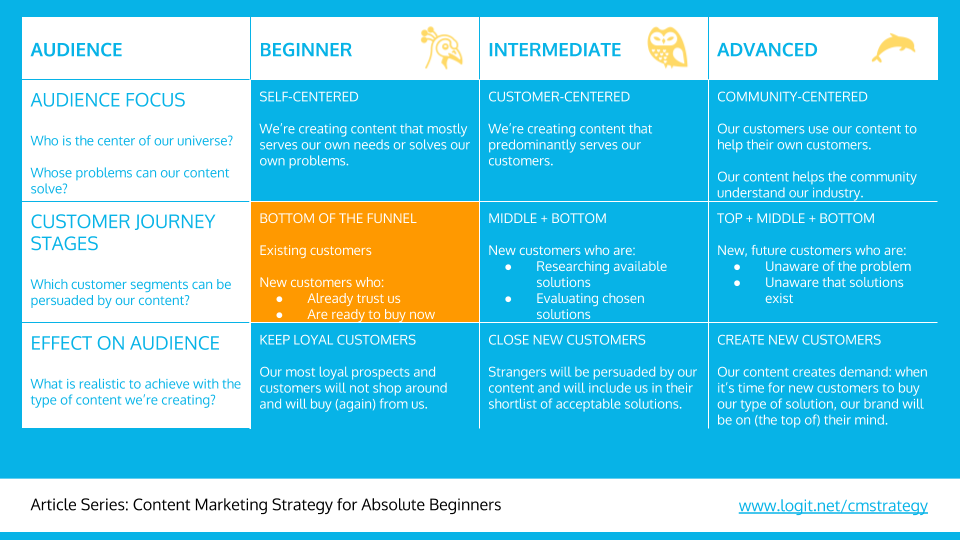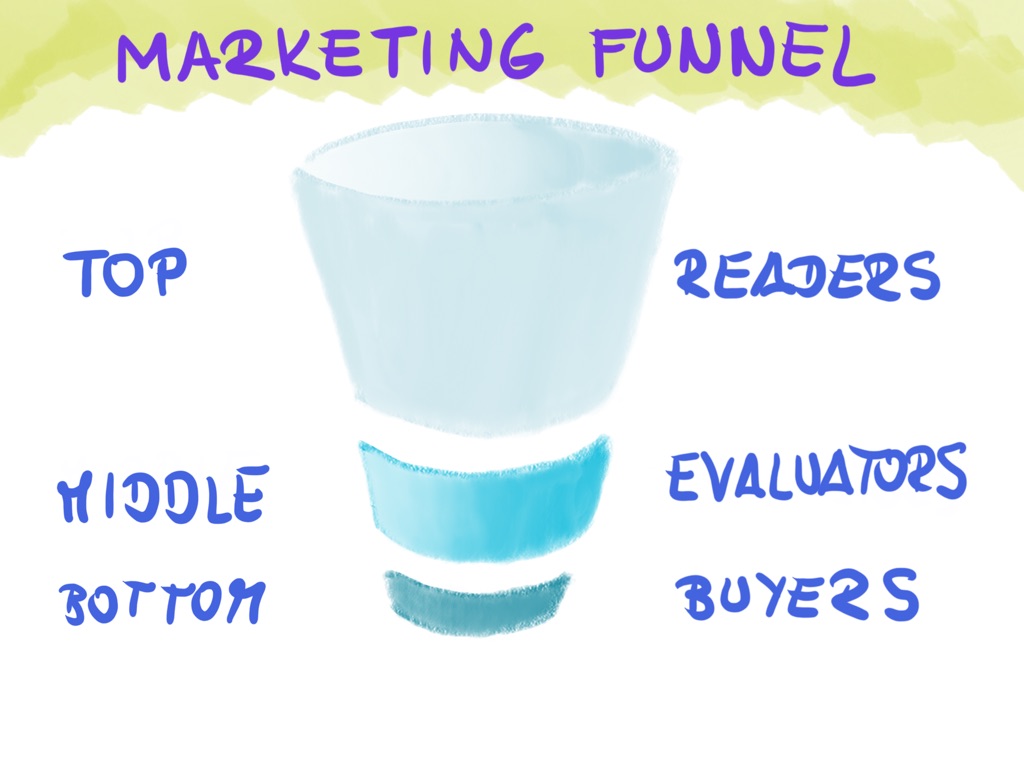(This article is part of the Content Marketing Strategy for Absolute Beginners article series.)
Let's start with the main premise of this article:
Every business blog post you publish and share becomes an opportunity to generate sales - directly or indirectly.
In our introduction to the four levels of content marketing mastery for B2B companies, you learned about how important it is for you as a beginner to not skip levels on your way to becoming an advanced content marketer.
Beginners are only capable of creating basic content such as business blog posts. If you're wondering what kind of sales results you can hope to achieve with basic content, and where those new customers will come from, read on.

What Are Business Blog Posts, Exactly?
Business blogging is a broad definition which stands for the act of publishing articles on your business website.
Not all blog posts are the same. For now, let's make an important distinction between two types of blog posts:
- Informative blog posts (articles about your company)
- Educational blog posts (articles addressing your customers' needs)
Before you tackle the educational content marketing forms which are harder to write well, we advise that you first learn how to write and regularly publish informative business blog posts, which are the focus of this article.
The Most Popular Types of Informative Business Blog Posts
Because these are easier to write, it becomes easier for you to keep a regular publishing schedule:
- Company news,
- Sales and marketing articles (including updates about your products, services, solutions, and projects delivered to customers and clients), and
- Corporate announcements on various topics.
By publishing these types of posts, you not only practice basic content writing skills, but you're also creating the foundation for generating actual sales. By writing about your company online, you're proving that you're alive, well, and in business.
(BTW if you need help writing business blog posts, check out the premium templates and worksheets in or Products section.)
Types of Customers on Which You Should Focus as a Beginner
If you write about your company regularly, you will:
- Generate some sales from existing customers, and
- Generate some sales from new customers.
(Don't let the 'some sales' formulation discourage you: most beginners don't generate any sales from their content. When we started this article series, we promised to keep it realistic for you and your skill level. Generating some results (and learning how to master content marketing in the process) is much better than generating no results at all.)
Not everyone will be interested in your informative blog posts. In fact, the majority of your potential customer base will be bored by those articles. Then why write those articles at all?
The answer is in the audience segment of your content marketing strategy:

There are two specific customer groups which will be interested in your informative blog posts:
- Your existing customers who are ready to buy from you again (repeat purchases), and
- New customers who already know about you, trust you, and are ready to buy from you now.
In marketing lingo, those customers belong to the so-called bottom of the marketing funnel (BOFU). Here's that funnel, visualized:

(Here's a good definition and explanation by Ahrefs what a marketing funnel is).
In the TOP of the funnel (TOFU) you'll find potential customers (prospects) who are not looking to buy a solution because they don't have a problem that needs a solution (yet). However, they're interested in reading and learning about problems and solutions targeting their industry.
In the MIDDLE of the funnel (MOFU) you'll find prospects who are actively looking for solutions and probably evaluating several of them.
In the BOTTOM of the funnel (BOFU) you'll find prospects who are ready to commit to one solution and buy now.
Why You Should Stick with the Bottom-of-the-Funnel (For Now)
BOFU segment is by far the smallest customer segment. This means that your informative content can influence only the smallest number of customers.
Wait now: shouldn't I focus on the two segments (MOFU and TOFU) where the most potential customers are? - we hear you ask.
The answer is: you should. Everyone should. However, there's a reason why not everyone can create content for MOFU and TOFU segments: it's much, much harder to create content for customers who are not ready to buy yet.
Here's what makes it hard:
First, before you can convince them to buy, you need to educate the customers in those two upper funnel segments about the problem you're solving and the solution you're offering. To be able to create quality educational content, your company needs to learn how to cross the chasm from a publishing company (beginner level) to a teaching company (intermediate level). The data we published in our article about the three content marketing chasms shows that fewer than 10% of all companies make it to the intermediate level.
Second, before they can read your content, potential customers must discover your content. Most content is discovered via search engines and social shares, and only the best content ranks well on both. This means that your content must be top notch in order to be discovered and, you're guessing it, it's getting increasingly harder to create and sustain creation of top-notch content.
Finally, creating top-notch content requires dedicated resources - money, time, and people - more than beginners are aware of. Everyone who tries to create intermediatel-level content without enough resources finds out very soon how difficult it is.
Do not despair. You can get to the intermediate level by practicing on the beginner level, and you can hope to reap some results on the way. The correct way to practice is to appeal to the types of customers with who you can have success, so that you remain motivated to keep producing content. This is why bottom-of-the-funnel customers are well worth your time if you're a beginner.
Source of Sales #1: Customers in the BOFU Segment
Here's who you can influence with your informative posts.
Existing Customers
You probably already have some customers and clients. If you're not publishing anything or speaking to them on regular basis, how are they supposed to know when you have something new or exciting to offer them? Publishing anything on your website, your social profiles, or in an email newsletter is a great way to generate repeat purchases.
Most Loyal Customers
Your informative business posts also remind your most loyal customers that you exist and that it's time for them to buy your products or renew their orders with you. They already love you and want to buy from you, but you can't be the first thing on their minds every day. You need to put yourself on the top of their mind, and you do that by blogging for business.
Prospects Who Already Know What You Sell
A small number of potential customers already know that you have solutions to their problems. It could be those people who heard you speak at a conference, who you met at a business event, or who are following your company online.
These prospects belong to a lucrative customer segment because they don't need you to teach them with content about what you can do for them. Somehow they already know that you have a solution for their problems, they already trust you, and they will be ready to buy at some time in the future.
Your informative content reminds them about you and removes other competitors from their radar. When the time comes to buy the solution you're selling, you will be on their short list of vendors.
Prospects Who Are Thinking About Buying From You Right Now
This customer segment is actually ready to talk to your sales department, but they're too busy to call you. They keep postponing their purchase for some reason and if your salespeople called, they would be delighted to hear from you: You must have read my mind, I was just thinking about calling you and starting the project!"
Yes, these prospects do exist. Your content serves as that final nudge that will make them pick up their phone and call you.
Source of Sales #2: 'Friendlies'
'Friendlies' are people who aren't your customers, but can greatly and indirectly contribute to generating new sales for you by mentioning and recommending you to their own customers and networks. And they'll do it for free, because they like you, trust you, believe in you, want to see you succeed, or simply know you personally.
Friendlies are important because they operate in channels you can't control, can't influence, and can't get access to:
- Offline and online word of mouth: people ready to buy are asking their friends for recommendations all the time.
- Email forwards: your emails may get forwarded to prospects.
- Social media shares: people are reading your company posts on Linkedin, Facebook, Twitter, and elsewhere. They may not always react to them, but what you publish ends up in their feeds and influences their thinking.
- Search results: your informative posts will reach people searching for your company name and very specific keywords, such as product names and people's first and last names.
Although these people aren't your customers themselves, your content informs the friendlies about your activities, which in turn makes them put in a good word on your behalf and send a customer or two your way.
So, who are these friendlies? Let's start with the most obvious, but often neglected ones: your own employees.
Your Own Employees
Your employees have social connections of their own and they use their networks of friends and family to brag about their successes or talk about their work like. You should make it trivially easy for them to share your business blog posts, and you can also entice them to do so.
Here's one example. You just completed an important project of which you're proud. Privately you informed your employees that the customer was happy with the project, and that their good work always helps the company attract more customers. Why not also write a blog post about that project, in which you publicly praise the good work of your team? Chances are some of your employees might share that post and tell their network that it was them who personally worked on the important project.
Business Partners
Your partners are interested in seeing your business succeed and will recommend you to their customers and their business network.
For example, your partners may forward your newsletter to their customer looking for your solution. Or, a blog post you wrote to celebrate your business anniversary* may pop up in their Linkedin feed, which they may like or share or comment on. This activity will trigger Linkedin's algorithm which may put your post in other people's feeds, which is one of the ways how you can reach complete strangers with your business blog posts.
* (If you want to blog about your business anniversary but don't know what to say, check out our premium template for writing anniversary blog posts.)
Friends and Family
Do your friends and family know exactly what you do, or at least enough to send new potential customers your way? Chances are they don't. However, your friends and family can learn the details of your business if you educate them. You do that by putting fresh new content where they will see it.
Example: Facebook is a great distribution tool which you can use to educate your friends and family about what you do. It's a good idea to use your personal Facebook account to occasionally post about your business. If you write a business post on your website about a new client, product, service or event, share it with your Facebook friends on your personal Facebook account.
From our experience, people do want to know what you do for a living; just make sure you don't overdo it with promotional posts. One promotional post among twenty-thirty regular posts is just fine. These social posts won't necessarily attract as many likes as your travel photos would, but our own experience tells us that people do pay attention to Facebook posts, even if they don't react to every one of them.
Consultants in Your Niche
Did the following ever happen to you? A customer contacts you to request a quote. When you ask them how they first learned about you, they say something like: "Oh, John Doe recommended you and spoke highly of you", but you have no idea who John is!
Good word of mouth such as this happens by the power of informed consultants. There are consultants in almost every industry and there's a chance some of them already know you exist. Some of them will have a positive impression of your brand, even if you never met them or talked to them. Consultants can recommend your solutions to their clients.
One of the many ways you can create a positive impression of your brand is to blog regularly about your company, products and services, customers, and your industry. If you also happen to regularly share your posts on your social channels, there's a chance these social posts will be seen by consultants who are actively seeking out information about the players in their industry. Consultants need to know who provides which solutions because their jobs depend on that information.
The more you talk about your work publicly, the more influence you can hope to exert on consultants, even though you have no idea who they are. Of course, for better results, you can always make a proactive effort to create a relationship with the many consultants in your niche, and then keep them in the loop about your work.
Members of the Press
Journalists are looking for subject matter experts to talk to, interview or quote all the time. They use Google, Linkedin, and other sources to research quality people and companies to supply information to them.
The least you can do to influence the journalists with who you don't have a prior relationship is to keep blogging for business and making your work accessible and findable online. It's not very likely, but it is possible a journalist might call one day to ask for your contribution to the piece they're writing. In our experience, exposure such as this only happens to companies who are actively working on their visibility. Blogging for business is one tiny, but easy way to increase your visibility.
Academia (Teachers, Reseachers, Students)
Teachers always need help with materials for their classes. They're constantly searching for people who could contribute with examples, personal experiences, case studies, good business practices, original stories, and guest lectures. If they recognize you as an expert in your field, they might ask you for help or invite you to give a lecture at their school. This will be the beginning of a beautiful business friendship because they may become a source of recommendations and positive word of mouth. It goes without saying that you should make the first step and invest in good relations with teachers and researchers at target universities.
Researchers at academic organizations are looking for specific data and information for their studies, scientific papers, and theses. You can get on their radar by blogging about interesting data and trends in your industry.
Students may be interested in getting a job at your company one day. They will follow your company online, which creates and interesting opportunity for you to educate them about what you do and who your customers are. Even if they get a job somewhere else, you've planted enough seeds in their minds to spark a future collaboration, business relationship, or a recommendation.
Follow us on Linkedin, Twitter or Facebook to get an update when we publish the next article in this series.
References
- [ARTICLE] How to Celebrate Your Business Anniversary: a Plan and 20+ Ideas for B2B Companies, logit.net
- [ARTICLE] The Three Content Marketing Chasms and What It Takes to Cross Them, logit.net
- [ARTICLE] The Four Levels of Content Marketing Mastery: Introduction, logit.net
- [ARTICLE] Marketing Funnels for Beginners: A Comprehensive Guide, ahrefs.com